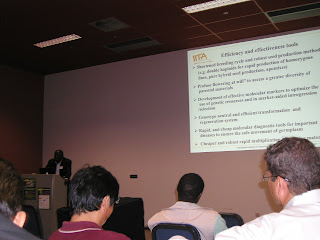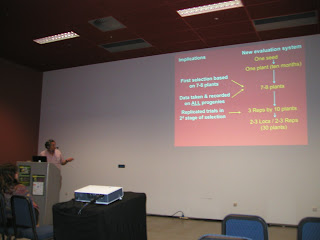1.1 Review of cassava production in Vietnam Cassava in Vietnam is among the four most important food crops (
Table 1). But it has always been considered a secondary crop even though it has played an important role in national food security.

During the past two decades of economic renovation, Vietnam has successfully escaped lingering food deficiency. Cassava now an important source of cash income to small farmers, who either use it for animal feeding or for sale to starch factories.
1.1.1 Cassava production areas. Viet Nam is a humid tropical, long and narrow country, located between latitudes 8.5° and 23.5° North and longitudes 102° and 110° East. The narrowest part is only 40 km wide. Toward the east lies the sea and towards the west the Truong Son Mountain range. The terrain is highly varied and tends to slope down towards the sea. This results in marked differences in soils and climatic conditions between regions (
Fig. 1),
 Figure 1
Figure 1: Agro-climatic map of Vietnam
Adapted from Agro-climatic map of SE Asia by Huke 1982
Source: Hoang Kim, Pham Van Bien and R.H. Howeler 2003
http://www.fao.org/docrep/009/y1177e/y1177e00.htm
Because of this topographic and climatic heterogenuity the country has been divided into seven more or less homogeneous agro-ecological zones i.e. the north Mountainous Region (which includes the Northern Highlands and Midlands), the Red River Delta, the North Central Coast, the South Central Coast, the Central Highlands, the Southeastern Region and the Mekong Delta
The soils of Viet Nam are closely associated with its topography. The mountainous and hilly areas of the northern and central part of the country are mainly Ultisols with some Oxisols in the more tropical regions of the south (
Fig.2)
 Figure 2
Figure 2: Soil map of Vietnam
Adapted from FAO World Soil Map by R.H. Howeler
Source: Hoang Kim, Pham Van Bien and R.H. Howeler 2003
http://www.fao.org/docrep/009/y1177e/y1177e00.htm
Large areas of Inceptisols are found mainly in the Mekong and Red River deltas as well as along smaller rivers and near the coast. The more recently developed Entisols are found mainly along riverbanks and along the coast. By overlying the cassava production map on the soils map, it is possible to estimate the area of the various soil orders on which cassava is grown. Thus, it was estimated that in Viet Nam about 66% of cassava is grown on Utisols, 17% on Inceptisols, 7% on Oxisols, 4% on Alfisols, 3% on Entisols and 2% on Vertisols (Howeler, 1992). The soil pH generally varies from 4.5 to 6.0. (Pham Van Bien et al., 1996)
In North Viet Nam about 68% of the cassava growing area has a rocky soil, while 18 and 12% have clayey and sandy soils, respectively. Rocky soils are prevalent in Ha Son Binh and Ha Bac provinces. Cassava is grown mainly in areas with ondulating and hilly topography. About 89% of cassava in North Viet Nam is grown on these kinds of soils (Pham Van Bien et al,1996).
In South Viet Nam most cassava soils are sandy in the Central Coastal area and in the Southeastern Region, while rocky soils predominate in Gia Lai-Kon Turn and are also common in Dac Lac province. The cassava growing areas in the provinces of the Central Highlands have a similar topography. In the Central Coastal Region and in the Southeastern Region, cassava is grown mainly on white-grey soils or coastal sandy soils. These regions are flat, soils are poor in nutrients and not suitable for rice cultivation. The cassava growing area in this type of soils accounts for more than 70% of the total cassava area of the south. In the Mekong Delta, cassava is not very important. Due to these marked differences in cassava soil characteristics, research in the north should concentrate on erosion problems and soil fertility enhancement, whereas in the south research on cassava soil improvement and conservation by using intercropping systems is of highest priority (Pham Van Bien et al.,1996).
The climate varies substantially between regions. The northern part of the country has a subtropical climate with low winter (15°C) and high summer (29°C) temperatures. Most rain falls during the summer months of May to September, but during the winter months of January-March there are many rainy days with almost constant drizzle, resulting in a low number of sunshine hours (
Fig. 3).
 Figure 3
Figure 3: Cassava cropping times in eight agro-ecological regions of Vietnam
Source: Hoang Kim, Pham Van Bien and R.H. Howeler 2003
http://www.fao.org/docrep/009/y1177e/y1177e00.htm
In the south, however, the climate is tropical with relatively small fluctuations in monthly temperatures (25–29°C). The rainy season is about one month delayed compared with the north, but total rainfall is similar. The dry season in the south is more intense, due to an almost complete lack of rain during 5–6 months. In the Central Coastal Region total rainfall is high, but it is poorly distributed with very heavy rainfall from September to November and a long dry season of 7–8 months.
Cassava production in Vietnam has mainly been allocated in the Central and Southeast with an increase in planted areas in 2001-2006 (see
Figure 4).
 Figure 4
Figure 4. Area and Output of Cassava in the Central provinces, Vietnam (1995-2006)
In 2006, cassava planted area has reached 474.8 thousand hectares, in which about 65% of total area was allocated in the Central and Southeast. It can be seen that the cassava production in Vietnam has been gradually shifted to the Central and the Southeast areas in the recent years, especially in Gia Lai, Kon Tum, Dak Nong and Dak Lak provinces in the Central highlands; Tay Ninh, Dong Nai, Binh Phuoc, Binh Thuan provinces in the Southeast; and Quang Nam, Quang Ngai, Binh Dinh and Phu Yen provinces in the South Central Coast. The three regions all have increased the areas of cassava production with different levels. Prominent among three regions is the Southeast with a significant increase in 2001.
1.1.2 Socio -economic conditions and cassava cultural practicesCassava farm size in Viet Nam is small and does not vary much among locations. But, cassava farms in the Southeastern Region are on average double the size of those in North Viet Nam. Cassava area per farm for all of Viet Nam is small as well, and average 0.27 ha, with extremes for the Southeast (0.85 ha) and the North Mountainous Region (0.20 ha). When farms are classified according to size, 31.6% of the sampled farms are smaller than 0.6 ha, 35.5% are between 0.6–1.05 ha, and the remaining 33% are larger than 1.05 ha. Cassava cultural practices vary among agro-ecological regions and to go into details at CassavaViet (http://cassavaviet.blogspot.com/)
1.1.3. Cassava yield and outputThere has a great achievement in cassava yield and output. During the 1980s and 1990s cassava production in Vietnam was in decline. But in the past six years, cassava production increased from 1.99 million tones in 2000 to 7.71 million tones in 2006. (
Figure 5) Cassava in Vietnam has rapidly changed its role from a food crop to an industrial crop, with a high rate of growth during the first years of the 21st Century.
 Figure 5
Figure 5. Cassava production and yield trends in Vietnam and Asia’s principal cassava producing countries, 1961-2006. (Source: Reinhardt Howeler and Keith Fahrne, 2008)
This was achieved through both area expansion, from 237,600 ha in 2000 to 474,800 ha in 2006, and marked increases in yield, from 8.36 tons/ha in 2000 to 16.25 tons/ha in 2006 (
Table 1). New high-yielding cassava varieties (
Table 4) and more sustainable production practices have increased the economic effectiveness of cassava production. In year 2006/07 about 350,000 ha of new varieties, mainly KM94, KM140, KM98-5, KM98-1, SM937-26, KM98-7 were grown, this corresponds to about 75 % of the total cassava area in whole country.

Cassava yields and production in several provinces have doubled, stimulated by the construction of new large-scale cassava processing factories. The cassava output in each region/province has been corresponding to the planted area and yield which greatly depends on the application of new high-yielding cassava varieties in each province and the adoption of more sustainable production practices (Pham Van Bien et al 2001, Hoang Kim et al. 2001) .
1.2 Review of cassava processing and market in Vietnam Cassava now an important source of cash income to small farmers, who either use it for animal feeding or for sale to starch factories. While eighteen years ago there were no medium- or large-scale cassava starch factories in Vietnam, there are now 60 cassava processing factories in operation with a total processing capacity of 3.2- 4.8 million tones of fresh roots/year. Total cassava starch production in Vietnam was about 800,000- 1,200,000 tones, of which 70% was exported and 30% used domestically. Vietnam is now probably the second largest exporter of cassava products, after Thailand with 4.46 and about 0.81 million tones of cassava products exported, respectively. (Table 5).

Major markets of Vietnam’s cassava exports are the P.R. of China and Taiwan, Japan, Singapore, Malaysia, South Korea and countries in Eastern Europe. Besides, animal feed factories also contributed significantly to the increasing demand for cassava roots. Although in Vietnam cassava processing is a relatively new business and export volumes are still low, the cassava processing factories are new and modern. That is why Vietnam’s cassava products may have a competitive advantage in the world market.
2.3 Case study of cassava market in the Central provinces of Vietnam On average, labour cost accounts for 59.9% of cassava production costs. In some regions, like the Binh Dinh and the Gia Lai, this may be as low as 52.8% and 68.7%, respectively (
Table 6)

The average labour requirement is 125 mandays/ha. The second largest cost item is fertilizer, constituting 41.8% in Binh Dinh and 24.7% in Gia Lai, depending on farmers’ investment in fertilizer. With the selling price of fresh root of 900 VND/kg; farmers can earn 10,720 to 11,200 thousand VND/hectare. The total variable cost of cultivation in 2007 was about US$ 455- 567.5/ha, at an average root yield of 22.0 t/ha, the production cost would be US$ 20.68- 25.79 /t fresh roots. Gross income is US$ 1,155- 1,237.5 /ha. Net income is US$ 670 - 700/ha
Cassava export volumes through Quy Nhon Port are 500,000 and 700,000 tons in 2006 and 2007, respectively, of which about 10% provided by Binh Dinh and 90% collected from surrounding province like Phu Yen, Gia Lai, and Quang Ngai, Kom Tum etc. Regarding market channel, it can be seen that though cassava chip in Binh Dinh accounts for small portion (10%) in total export though Quy Nhon Port, Binh Dinh however, have its own advantages of having Port and in collecting chip from surrounding provinces.
In Binh Dinh province in 2007, about 250,541 tons fresh root has been sold in the market (81%). Reporting of farmers: 32% of fresh root has been processed by farmers for exportation; 22% of fresh root farmers sell to processing households, who process starch for domestic consumption; 19% farmers use for animal feeding or domestic consumption such as alcohol, cassava paper cake and so on. There has been only one cassava starch processing company with purchasing capacity of 27% total fresh root (Nguyen Van Ngai, Hoang Kim, Le Thanh Loan, Trần Van Loi, Nguyen Quoc Bao, 2008 - unpublish).





















































